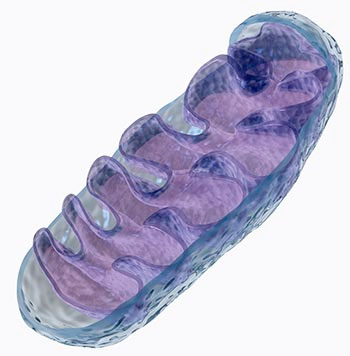Genes in mitochondria, the “powerhouses” that turn sugar into energy in human cells, shape each person’s risk for heart disease and diabetes, according to a study published recently by UAB researchers in the Biochemical Journal. The findings may further explain why some people get sick and others do not despite their having the same traditional risk factors like aging, obesity and smoking.
 A mitochondrion, or cell powerhouseResearchers have long sought to determine disease risk by looking at diet and variations in nuclear genes, leaving out differences in mitochondrial genes, the second kind of DNA in every cell.
A mitochondrion, or cell powerhouseResearchers have long sought to determine disease risk by looking at diet and variations in nuclear genes, leaving out differences in mitochondrial genes, the second kind of DNA in every cell.
Research in recent years revealed that miscues in mitochondrial energy production create too many particles called oxidants and free radicals that cause cells to self-destruct as part of heart disease, diabetes and cancer.
“Having been in this field for decades, I remember when mitochondrial DNA variations were thought to play a role only in the rarest of genetic syndromes,” said Scott Ballinger, Ph.D., professor in the Division of Molecular and Cellular Pathology within the UAB School of Medicine, and corresponding study author. “Today, there is a growing consensus that variations in mitochondrial DNA alone make a substantial contribution to each person’s risk for heart disease, and ours is the first study to directly confirm it in a living mammal.”
Ballinger’s study results reflect the theory that our ancient, one-celled ancestors “swallowed” the bacterial forbears of what are now mitochondria. The newcomers gave their hosts the ability to convert sugar from food into about 15 times as much cellular energy as they could before by using oxygen. Evolution favored the match, and mitochondria became permanent sub-compartments of human cells.
For that reason, each human cell now has two genomes, the long stretches of DNA that encode the blueprint for the human body: one set inherited from both parents in a centrally located nucleus, and a separate, smaller set in each mitochondrion passed down from mom thanks to details of cell division.
The theory that maternally inherited, mitochondrial DNA shape disease risk has been hard to prove. The field has struggled to genetically engineer mice that would enable researchers to separate the impact of one gene set from the other. Additionally, the human nuclear genome contains more than 30,000 genes compared to a mere 13 energy-related genes in mitochondria, so few researchers paid them much attention.
Read more about the technology.
